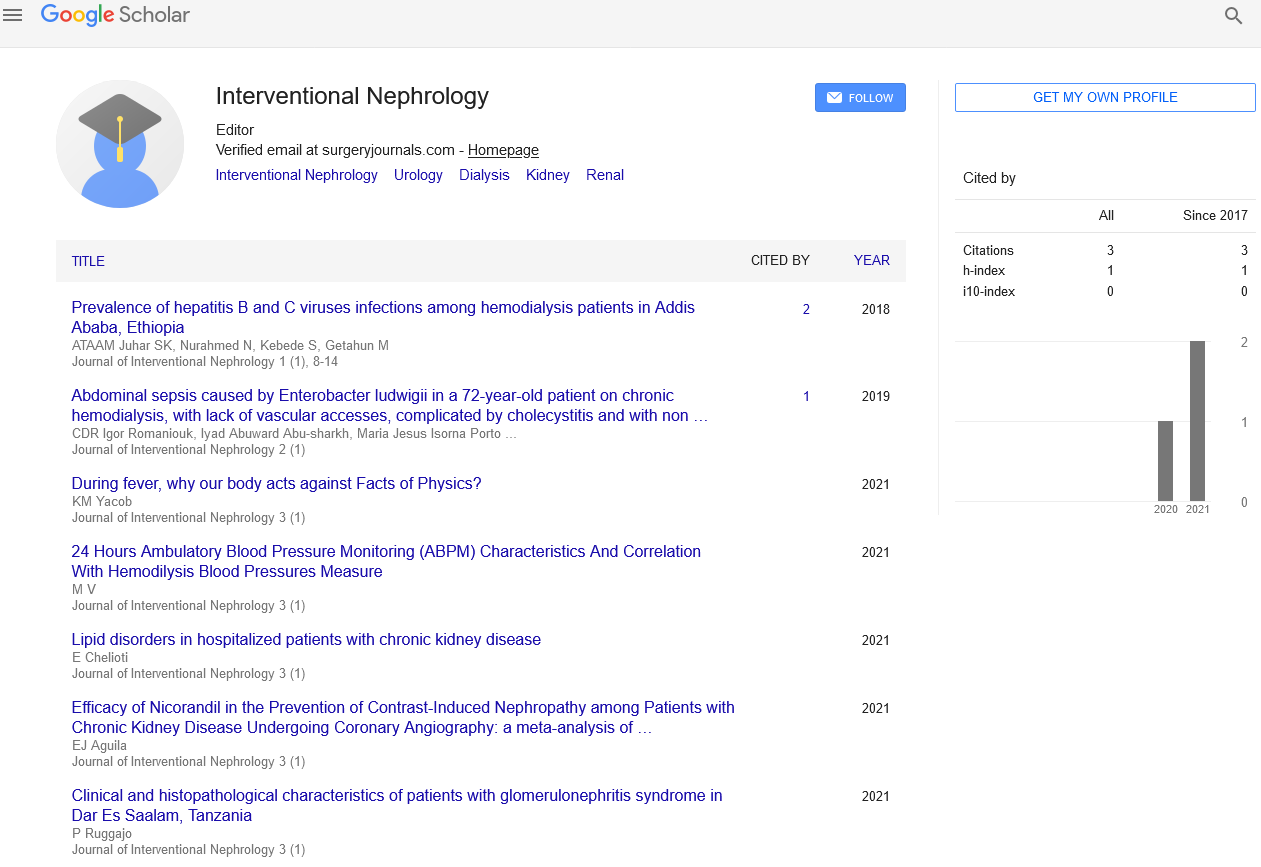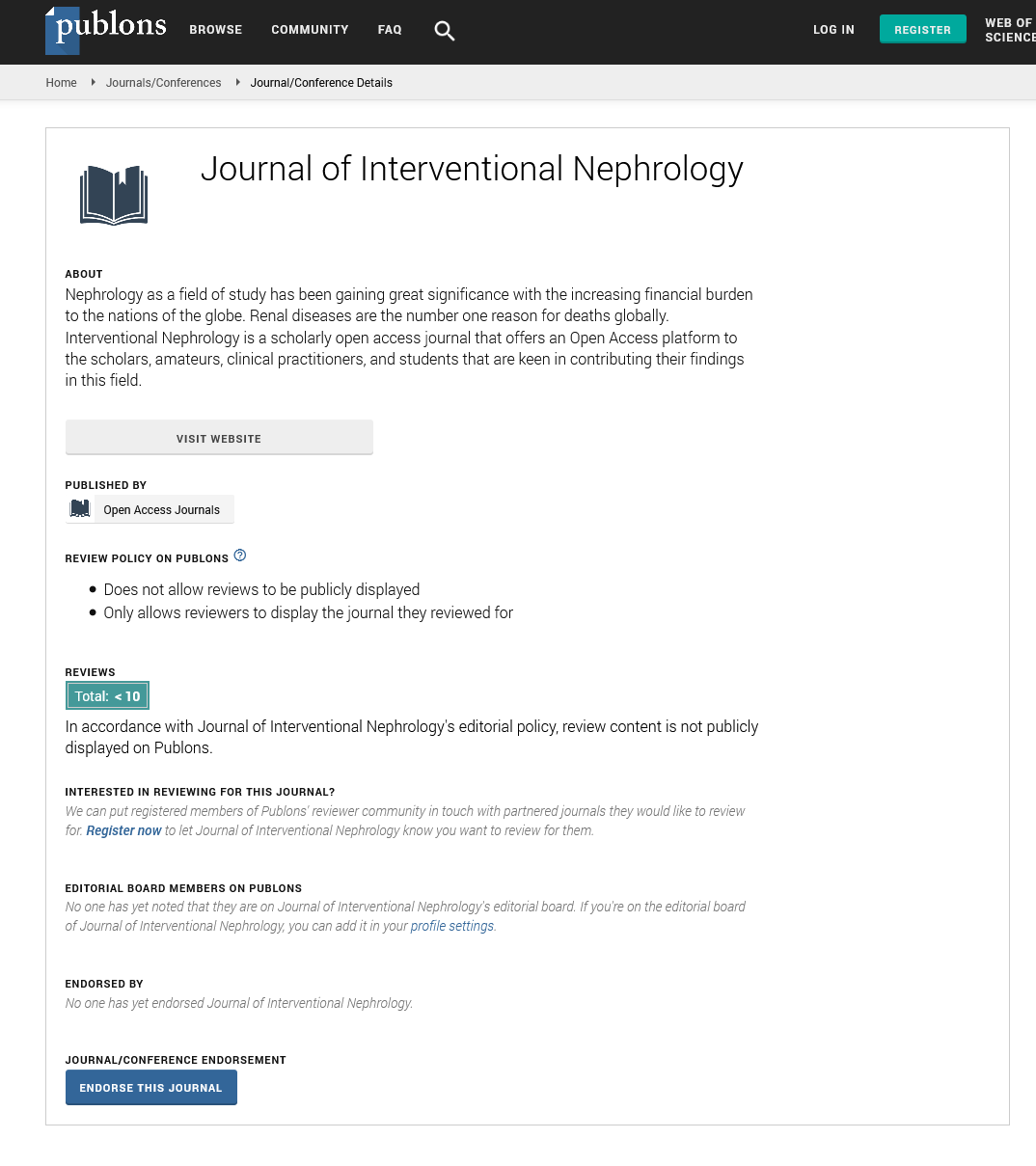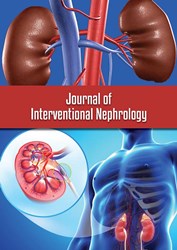Perspective - Journal of Interventional Nephrology (2024) Volume 7, Issue 2
Navigating Renal Tubular Disorders: Insights into Causes, Symptoms, Diagnosis, and Treatment
- Corresponding Author:
- Ajinath Shelke
Department of Nephrology,
NIILM University,
Germany
E-mail: Ajinaths646436mn@gmail.com
Received: 20-Mar-2024, Manuscript No. OAIN-24-130175; Editor assigned: 22-Mar-2024, PreQC No. OAIN-24-130175 (PQ); Reviewed: 05-Apr-2024, QC No. OAIN-24- 130175; Revised: 12-Apr-2024, Manuscript No. OAIN-24-130175 (R); Published: 22-Apr-2024, DOI: 10.47532/oain.2024.7(2).244-245
Abstract
Renal tubular disorders encompass a diverse group of conditions characterized by dysfunction or impairment of the renal tubules, leading to abnormalities in electrolyte balance, acid-base homeostasis, fluid regulation, and urinary concentration. In this comprehensive article, we embark on an exploration of renal tubular disorders, shedding light on their underlying mechanisms, clinical manifestations, diagnostic approaches, and therapeutic strategies.
Keywords
Electrolyte balance ● Medications ● Toxins ● Metabolic disturbances ● Hypercalcemia
Introduction
Understanding renal tubular disorders
The renal tubules play a pivotal role in the reabsorption and secretion of various solutes and water, facilitating the maintenance of electrolyte balance, acid-base equilibrium, and fluid volume regulation within the body. Renal tubular disorders arise when these physiological processes are disrupted, resulting in impaired renal tubular function and subsequent electrolyte imbalances or metabolic abnormalities.
Etiology and pathophysiology
Renal tubular disorders can be congenital or acquired, with a wide array of underlying etiologies contributing to their development. Congenital forms may result from genetic mutations affecting ion transporters, channels, or enzymes involved in tubular reabsorption or secretion. Acquired tubular disorders may arise secondary to systemic diseases, medications, toxins, or metabolic disturbances, leading to tubular injury or dysfunction.
Clinical manifestations
The clinical presentation of renal tubular disorders can vary depending on the specific tubular defect, its severity, and the compensatory mechanisms employed by the kidneys. Common manifestations may include:
• Electrolyte imbalances, such as
hypokalemia, hyperkalemia, hypocalcemia,
or hypercalcemia, resulting from defects in
tubular reabsorption or secretion.
• Acid-base disturbances, including
metabolic acidosis or alkalosis, arising
from impaired hydrogen ion secretion or
bicarbonate reabsorption.
• Polyuria or oliguria due to alterations in
tubular water reabsorption, leading to
excessive or reduced urinary output.
• Nephrolithiasis or nephrocalcinosis
secondary to abnormal urinary solute
concentrations or crystal formation
within the renal tubules.
• Growth retardation, failure to thrive, or
developmental delays in pediatric patients
with severe or longstanding tubular
disorders.
Description
Diagnostic evaluation
Diagnosing renal tubular disorders requires a systematic approach, incorporating clinical assessment, laboratory testing, and imaging studies to elucidate the underlying pathophysiology and identify potential precipitating factors. Key diagnostic modalities may include:
• Comprehensive Metabolic Panel (CMP)
and Arterial Blood Gas (ABG) analysis to
assess electrolyte levels, renal function, and
acid-base status.
• Urinalysis and urine electrolyte measurements
to evaluate urinary electrolyte excretion,
osmolality, and pH.
• Serum and urine osmolality testing to assess
the kidney’s ability to concentrate or dilute
urine appropriately.
• Genetic testing or molecular studies in
select cases of suspected congenital tubular
disorders.
• Imaging studies, such as renal ultrasound
or CT scan, to assess for structural
abnormalities or complications associated
with tubular dysfunction.
Management and treatment strategies
The management of renal tubular disorders aims to address underlying electrolyte abnormalities, correct acid-base disturbances, and mitigate associated complications. Treatment strategies may include:
• Electrolyte supplementation or restriction
to correct imbalances and restore normal
serum levels of sodium, potassium, calcium,
and magnesium.
• Pharmacological interventions, such as
alkali therapy with oral bicarbonate or
citrate preparations to manage metabolic
acidosis or prevent stone formation.
• Fluid management strategies to optimize
hydration status and prevent volume
depletion or overload.
• Avoidance of nephrotoxic medications, toxins, or dietary factors that may exacerbate
tubular dysfunction or impair renal function.
• Close monitoring of renal function,
electrolyte levels, and urinary parameters
to assess treatment response and adjust
therapeutic regimens as needed.
Prognosis and complications
The prognosis of renal tubular disorders varies depending on several factors, including the underlying etiology, severity of tubular dysfunction, and the presence of associated comorbidities or complications. While many cases of tubular disorders respond favorably to treatment and supportive care, severe or untreated forms can lead to significant morbidity, renal impairment, or even end-stage kidney disease in some instances.
Future directions and research perspectives
Advancements in molecular genetics, functional imaging, and targeted therapies hold promise for improving the diagnosis, management, and outcomes of renal tubular disorders. Ongoing research efforts aimed at elucidating the genetic basis of tubular dysfunction, identifying novel therapeutic targets, and developing targeted interventions may pave the way for personalized treatment approaches and precision medicine in the future.
Conclusion
Renal tubular disorders represent a heterogeneous group of conditions characterized by dysfunction or impairment of the renal tubules, leading to electrolyte imbalances, acid-base disturbances, and urinary abnormalities. Through a comprehensive understanding of the underlying mechanisms, clinical manifestations, and diagnostic approaches, clinicians can effectively diagnose and manage renal tubular disorders, striving to optimize patient outcomes and quality of life.


